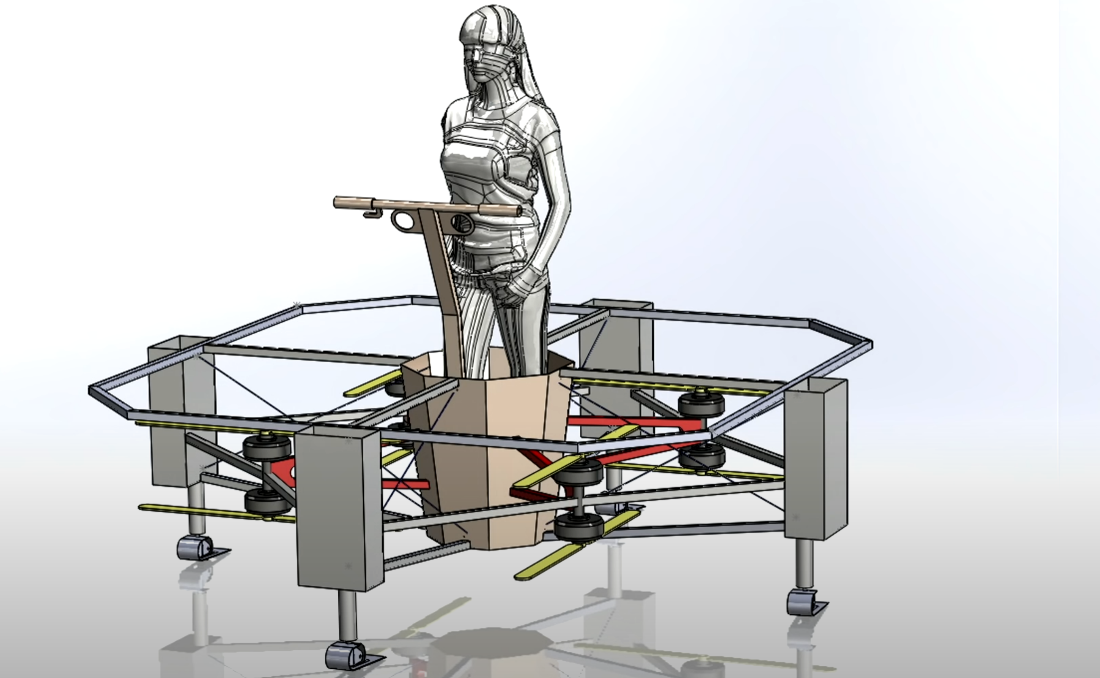The ‘Open Enough Challenge’ — investigating tensions in open innovation approaches to aerospace R&D
Investigating Tensions in Open Innovation approaches to aerospace R&D
DOI:
https://doi.org/10.55225/sti.588Keywords:
open innovation, innovation challenge, eVTOL, drones, Social Media, infrastructuring tensions, flattening innovationAbstract
In this paper, we investigate the transformative potential that emerging eVTOL- / drone- technology exerts on the relationship between established aerospace R&D processes and their adaptation of open innovation (OI) approaches. Empirically, we draw on the ethnographic and digital ethnographic study of two open innovation challenges, the Boeing GoFly-Prize and the Airbus Deep Drone Challenge. We investigate how tensions emerged in the negotiation process between open and closed innovation approaches throughout the challenges and which measures were taken to mediate them. The concept of ‘infrastructuring tensions’ is applied to shift the perspective from tensions as unwelcome hindrances to integral parts of this negotiation process that require maintaining and that are indicative of opportunities in the adaption of OI approaches.
We differentiate the investigation in terms of the challenges’: a) frameworks toward shared eVTOL-innovation; b) accessibility for their participants; c) compatibility between internal R&D processes, market requirements, and participants’ expectations.
We conclude that such challenges are examples of what we consider ‘flattening innovation’, a process that builds on open innovation approaches, yet cannot fully employ them. Instead, we observed an interplay where challenges that are communicated as fundamentally open require continuous navigation and re-evaluation to both satisfy participants’ demands for accessible open formats as well as companies’ demands for compatibility toward their own R&D processes and available markets.
Downloads
References
Gassmann G, Enkel E, Chesbrough H. The future of open innovation. R&D Management. 2010;40(3):213–221. https://doi.org/10.1111/j.1467-9310.2010.00605.x. DOI: https://doi.org/10.1111/j.1467-9310.2010.00605.x Google Scholar
Reichwald R, Piller F. Open Innovation: Kunden als Partner im Innovationsprozess. In: Foschiani S, Habenicht W, Wäscher G, editors. Strategisches Wertschöpfungsmanagement in dynamischer Umwelt. Frankfurt: Peter Lang; 2005. p. 51–78. Google Scholar
Acar OA. Motivations and solution appropriateness in crowdsourcing challenges for innovation. Research Policy. 2019;48(8):103716. https://doi.org/10.1016/j.respol.2018.11.010. DOI: https://doi.org/10.1016/j.respol.2018.11.010 Google Scholar
Merchant R, Asch DA, Hershey JC, et al. A crowdsourcing innovation challenge to locate and map automated external defibrillators. Circulation: Cardiovascular Quality and Outcomes. 2013;6(2):229-236. https://doi.org/10.1161/CIRCOUTCOMES.113.000140. DOI: https://doi.org/10.1161/CIRCOUTCOMES.113.000140 Google Scholar
Majchrzak A, Malhotra A. Toward an information system perspective and research agenda on crowdsourcing for innovation. The Journal of Strategic Information Systems. 2013;22(4):257–268. https://doi.org/10.1016/j.jsis.2013.07.004. DOI: https://doi.org/10.1016/j.jsis.2013.07.004 Google Scholar
Air [Internet, cited 2024 May 26] Available from: https://www.airev.aero/. Google Scholar
Air Evtol. Behind the scenes with AIR [Internet]. 2022. [cited 2024 May 26] Available from: https://www.youtube.com/watch?v=1g5gLNfV--o. Google Scholar
Chesbrough H. Open Innovation: The New Imperative for Creating and Profiting from Technology. Harvard: Harvard Business School Press; 2003. Google Scholar
Enkel E, Gassmann G. Open Innovation: Die Öffnung des Innovationsprozesses erhöht das Innovationspotenzial. ZFO Wissen Open Innovation. 2006;26:6-11https://doi.org/10.1007/s11621-009-0025-6. DOI: https://doi.org/10.1007/s11621-009-0025-6 Google Scholar
Möslein K, Neyer A. Open innovation. In: Zerfaß A, Möslein KM, editors Kommunikation als Erfolgsfaktor im Innovationsmanagement: Strategien im Zeitalter der Open Innovation. Wiesbaden: Gabler Verlag; 2009. p. 85–103. DOI: https://doi.org/10.1007/978-3-8349-8242-1_4 Google Scholar
Seltzer E, Mahmoudi D. Citizen participation, open innovation, and crowdsourcing: Challenges and opportunities for planning. Journal of Planning Literature. 2012;28(1):3–18. https://doi.org/10.1177/0885412212469112. DOI: https://doi.org/10.1177/0885412212469112 Google Scholar
Malpas O. Place and Experience. Cambridge: Cambridge University Press; 1999. DOI: https://doi.org/10.1017/CBO9780511487606 Google Scholar
Schikowitz A, Maasen S, Weller K. Constitutive tensions of transformative research: Infrastructuring continuity and contingency in public living labs. Science & Technology Studies. 2023;36(3):60–77. https://doi.org/10.23987/sts.122123. DOI: https://doi.org/10.23987/sts.122123 Google Scholar
Kuhn T. The Essential Tension: Selected Studies in Scientific Tradition and Change. Chicago: University of Chicago Press; 1997. Google Scholar
Star SL. The ethnography of infrastructure. American Behavorial Scientist. 1999:43(3):377–391. https://doi.org/10.1177/0002764992195532. DOI: https://doi.org/10.1177/00027649921955326 Google Scholar
Star S, Bowker G. How to infrastructure. In: Lievrouw LA, Livingstone SM, editors. Handbook of New Media: Social Shaping and Consequences of ICTs. London: Sage; 2002. Google Scholar
Hine C. Virtual Ethnography. London: Sage; 2000. DOI: https://doi.org/10.4135/9780857020277 Google Scholar
Kozinets RV. Netnography: The Essential Guide to Qualitative Social Media Research. London: Sage. 2019. DOI: https://doi.org/10.4324/9781003001430-2 Google Scholar
Hine C. Virtual ethnography: Modes, varieties, affordances. The SAGE handbook of online research methods. 2008. DOI: https://doi.org/10.4135/9780857020055.n14 Google Scholar
Hine C. From virtual ethnography to the embedded, embodied, everyday internet. In: Hjorth L, Horst H, Galloway A, Bell G, editors. The Routledge Companion to Digital Ethnography. New York–London: Routledge; 2017. Google Scholar
Angelone L. Virtual ethnography: The post possibilities of not being there. Mid-Western Educational Researcher. 2019;31(3):275–295. Google Scholar
Weller K, Holaschke M. Whose stream is this anyway? Exploring layers of viewer-integration in online participatory videos. Journal of Media and Communication Studies. 2022;14(1):17–32. https:doi.org/ 0.5897/JMCS2021.0760. DOI: https://doi.org/10.5897/JMCS2021.0760 Google Scholar
Inauen M, Schenker-Wicki A. The impact of outside-in open innovation on innovation performance. European Journal of Innovation Management. 2011;14(4):496–520. https://doi.org/10.1108/14601061111174934. DOI: https://doi.org/10.1108/14601061111174934 Google Scholar
Elmquist Elmquist M, Segrestin B. Sustainable development through innovative design: lessons from the KCP method experimented with an automotive firm. International Journal of Automotive Technology and Management. 2009;9(2):229–244. https://doi.org/10.1504/IJATM.2009.026399. DOI: https://doi.org/10.1504/IJATM.2009.026399 Google Scholar
Go Fly [Internet, cited 2024 May 26; Nov. 10] Available from: https://www.herox.com/GoFly. Google Scholar
Deep Drone Challenge Finale am 07. August 2021. [Internet]. 2021 Aug. 9. [cited 2024 May 26]. Available from: https://brigk.digital/news/deep-drone-challenge-finale/. Google Scholar
Finale der Deep Drone Challenge steigt am 07. August 2021. [Internet]. 2021 Jul. 16. [cited 2024 May 26]. Available from: https://brigk.digital/news/finale-der-deep-drone-challenge-steigt-am-07-august-2021/. Google Scholar
GoFlyPrize. GoFly Meet the Teams: Team DragonAir. [Internet]. 2019. [cited 2024 May 26]. Available from: https://www.youtube.com/watch?v=wQtwz3tJbEk. Google Scholar
GoFlyPrize. GoFly 2023. [Internet]. 2023. [cited 2024 May 26]. Available from: https://www.youtube.com/watch?v=4TAy7MArWBo. Google Scholar
GoFlyPrize. GoFly Prize. [Internet; cited 2024 May 26]. Available from: https://www.youtube.com/@GoFlyPrize. Google Scholar
GoFlyPrize. Master Lecture: Ducted Lift Fans w/ Bob Parks. [Internet]. 2019. [cited 2024 May 26]. Available from: https://www.youtube.com/watch?v=i31pXk6ayPY. Google Scholar
BrigkAIR Startup Incubator. DeepDroneChallenge 2021 FINAL incl. Interviews. [Internet]. 2022. [cited 2024 May 26]. Available from: https://www.youtube.com/watch?v=UfSJZiyDEdQ. Google Scholar

Downloads
Published
How to Cite
Issue
Section
License
Copyright (c) 2024 Kevin Weller, Michael Holaschke

This work is licensed under a Creative Commons Attribution-ShareAlike 4.0 International License.



